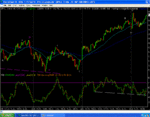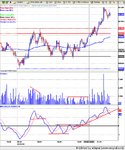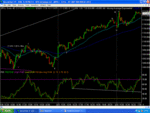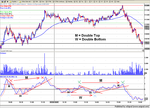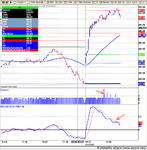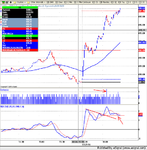Found this on beta's for the peeps who are not rocket scientists.
Beta is the sensitivity of a stock's returns to the returns on some market index (e.g., S&P 500). Beta values can be roughly characterized as follows:
b less than 0
Negative beta is possible but not likely. People thought gold stocks should have negative betas but that hasn't been true.
b equal to 0
Cash under your mattress, assuming no inflation
beta between 0 and 1
Low-volatility investments (e.g., utility stocks)
b equal to 1
Matching the index (e.g., for the S&P 500, an index fund)
b greater than 1
Anything more volatile than the index (e.g., small cap. funds)
b much greater than 1 (tending toward infinity)
Impossible, because the stock would be expected to go to zero on any market decline. 2-3 is probably as high as you will get.
More interesting is the idea that securities MAY have different betas in up and down markets. Forbes used to (and may still) rate mutual funds for bull and bear market performance.
Alpha is a measure of residual risk (sometimes called "selecting risk") of an investment relative to some market index. For all the gory details on Alpha, please see a book on technical analysis.
Here is an example showing the inner details of the beta calculation process:
Suppose we collected end-of-the-month prices and any dividends for a stock and the S&P 500 index for 61 months (0..60). We need n + 1 price observations to calculate n holding period returns, so since we would like to index the returns as 1..60, the prices are indexed 0..60. Also, professional beta services use monthly data over a five year period.
Now, calculate monthly holding period returns using the prices and dividends. For example, the return for month 2 will be calculated as:
r_2 = ( p_2 - p_1 + d_2 ) / p_1
Here r denotes return, p denotes price, and d denotes dividend. The following table of monthly data may help in visualizing the process. (Monthly data is preferred in the profession because investors' horizons are said to be monthly.)
Nr. Date Price Div.(*) Return
0 12/31/86 45.20 0.00 --
1 01/31/87 47.00 0.00 0.0398
2 02/28/87 46.75 0.30 0.0011
. ... ... ... ...
59 11/30/91 46.75 0.30 0.0011
60 12/31/91 48.00 0.00 0.0267
(*) Dividend refers to the dividend paid during the period. They are assumed to be paid on the date. For example, the dividend of 0.30 could have been paid between 02/01/87 and 02/28/87, but is assumed to be paid on 02/28/87.
So now we'll have a series of 60 returns on the stock and the index (1...61). Plot the returns on a graph and fit the best-fit line (visually or using some least squares process):
| * /
stock | * * */ *
returns| * * / *
| * / *
| * /* * *
| / * *
| / *
|
|
+------------------------- index returns
The slope of the line is Beta. Merrill Lynch, Wells Fargo, and others use a very similar process (they differ in which index they use and in some econometric nuances).
Now what does Beta mean? A lot of disservice has been done to Beta in the popular press because of trying to simplify the concept. A beta of 1.5 does not mean that is the market goes up by 10 points, the stock will go up by 15 points. It doesn't even mean that if the market has a return (over some period, say a month) of 2%, the stock will have a return of 3%. To understand Beta, look at the equation of the line we just fitted:
stock return = alpha + beta * index return
Technically speaking, alpha is the intercept in the estimation model. It is expected to be equal to risk-free rate times (1 - beta). But it is best ignored by most people. In another (very similar equation) the intercept, which is also called alpha, is a measure of superior performance.
Therefore, by computing the derivative, we can write:
Change in stock return = beta * change in index return
So, truly and technically speaking, if the market return is 2% above its mean, the stock return would be 3% above its mean, if the stock beta is 1.5.
One shot at interpreting beta is the following. On a day the (S&P-type) market index goes up by 1%, a stock with beta of 1.5 will go up by 1.5% + epsilon. Thus it won't go up by exactly 1.5%, but by something different.
The good thing is that the epsilon values for different stocks are guaranteed to be uncorrelated with each other. Hence in a diversified portfolio, you can expect all the epsilons (of different stocks) to cancel out. Thus if you hold a diversified portfolio, the beta of a stock characterizes that stock's response to fluctuations in the market portfolio.
So in a diversified portfolio, the beta of stock X is a good summary of its risk properties with respect to the "systematic risk", which is fluctuations in the market index. A stock with high beta responds strongly to variations in the market, and a stock with low beta is relatively insensitive to variations in the market.
E.g. if you had a portfolio of beta 1.2, and decided to add a stock with beta 1.5, then you know that you are slightly increasing the riskiness (and average return) of your portfolio. This conclusion is reached by merely comparing two numbers (1.2 and 1.5). That parsimony of computation is the major contribution of the notion of "beta". Conversely if you got cold feet about the variability of your beta = 1.2 portfolio, you could augment it with a few companies with beta less than 1.
If you had wished to figure such conclusions without the notion of beta, you would have had to deal with large covariance matrices and nontrivial computations

